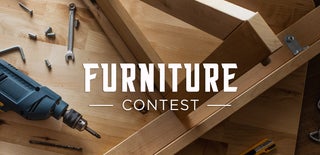Introduction: Side Table From Pallet Wood and Recycled Materials
For Christmas this year, I decided that it would be nice to make some things for my family rather than buying gifts. I'm a fan of recycled material projects which lead to my use pallet wood for a table top and old pieces of angle iron for table legs.
I do not like the simple look of boards as the frame for pallet wood tables, so I designed the top to be multiple boards stacked and glued together. The simple change makes a big aesthetic difference for me. I do not have an electric planer so I had to find some creative solutions you might like. Not having a tool should not prevent you from making things.
Tools I used
- table saw
- jigsaw
- angle grinder w/ flap disc and cutoff wheel
- belt sander
- blowtorch
- squares
- sandpaper
- rivet gun
Step 1: Step 1: Refine the Wood
Pallet wood is not the nicest looking wood, raw off the pallet. With some work it can be made into attractive boards. I used a table saw to cut the boards in half so the table was not too thick. Then I adjusted the fence of the saw so the blade was thinly shaving the rough exterior wood off the board. I repeated this process for all the sides and used the ones that were still too rough as firewood.
The holes from previous nails are not visible after you sandwich the boards together. The same is true for knots in the wood.
Step 2: Step 2: Glue the Boards
My table measurements were 1ft by 1ft, however I did not have enough board to make something that wide. Luckily the boards were long enough that I could make 2, 6in by 1ft sections. I glued these sections individually and then together once they were dry.
The problem with pallets started to emerge here. All of the boards were different sizes so it was difficult to make a straight surface. I got around this by putting all the boards on my table so that the bottom side would be flat. I flipped it over afterwards to get the flat surface.
If you do not care about the look of the boards on the sides, you can stack them any way you want. If you prefer a cleaner look, only put the nicer looking boards on the ends and use other pieces of wood as buffers when clamping the boards together so they do not leave marks. Be careful of what side you put down on your table because the good looking side should be face down because that will become the top of the table.
Step 3: Step 3: Shaping the Table
This is the most important step to make your table look good. The table needed to be planed so the table has a flat top. I do not have an electric planer but I still needed to get the table flat so I tried using hand planers, an angle grinder with flap discs, and a belt sander with a high grit belt. The grinder and planers worked the best at removing uneven surface material but I'm not very good at using them so the surface was not completely flat. Once I had the table almost flat, I used the belt sander to smooth the top out.
Another challenge presented itself here. Since the ends were not uniform (too thick or thin), I could not create a straight edge on the table saw. I decided to just draw a square on the board and cut it out using a jigsaw. I lost some material but the final length of the sides was around 10in, so it had little effect.
Step 4: Step 4: Legs
I used recycled angle iron for the legs. I attached the legs one at a time using screws and a large square to keep the legs at 90 degrees to the table top. This process was easy but I needed to re-do one of the legs because the screw was not grabbing the wood. I bought a small pack of larger screws to replace the smaller ones that I used for the rest of the legs.
The braces were made from aluminum bars. I cut them the same length as the side of the table which allowed me to make sure that the legs were straight all the way to the ground. I riveted the aluminum bars to the legs after marking and drilling holes through them.
Step 5: Step 5: Finishing Touches and Final Thoughts
Rather using a wood stain to finish the table, I applied a burnt wood finish. I used a blowtorch and slowly waved it above the table surface making sure not to over-burn it. This blackens the wood while keeping the grain visible. The re-bar stamp in the photo above is my maker mark, which I stamped into the top with.
I painted the aluminum braces and screw heads with black spray paint and sealed everything with a clear gloss spray.
Final Thoughts
I enjoyed making this project even though I experienced some challenges throughout the build. I highly encourage everyone to reuse materials in their projects, so we can reduce waste in the maker community. I hope you enjoyed this Instructable. Have fun trying it yourself.

Participated in the
Furniture Contest









